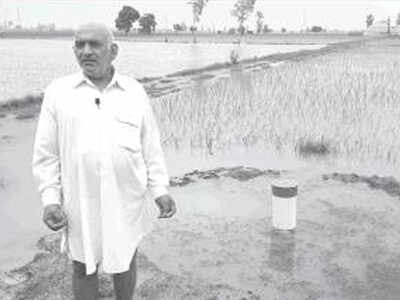
KARNAL: Haryana government croaks itself dry, like frogs in rain, to save water, but lets the water under the bridge by refusing to fix its problems. In Karnal district, for instance, nearly 45 rainwater harvesting systems, of the 97 that was installed in government departments and schools, lie broken. Given that, initiatives like that of the two farmers, Bhajan Lal and Narinder Kamboj, of Ramana Ramani village of Karnal, serve as truly inspiring stories to motivate others.
The farmers have set an example by installing rainwater harvesting system in their fields, spending Rs 70,000 each from their pockets.
“I have been suggesting this to the farmers in my village since 2016, nobody would listen to me. But today they realize not only I am harvesting rainwater, but I also managed to find a solution to water inundated fields during monsoons. Like most, every year my paddy crop used to be submerged in the monsoon season, not any more.”
Bhajan Lal said his rainwater harvesting system is 250 feet deep, in which 175 feet pipe (including filter) has been installed so that water can easily seep down, preventing waterlogging and, at the same time, raising the water table as well.
According to him, the government, which is dealing with the acute fall in the groundwater table in the region — seven blocks of the district fall in the overexploited category — should help more farmers like him to install such a system by supporting them financially.
Tejinder Singh Teji, member of the Haryana Pond and Waste Water Management Authority said, “I came to know about the rainwater harvesting systems that were installed by two farmers of Ramana Ramani village in their fields. I also visited their fields. It is a good initiative taken by the farmers. Every farmer should take motivation from Bhajan Lal and Narinder Kamboj.”
Suresh Madan, another farmer of Ramana Ramani village said he would like to install the system in his field, but unfortunately he cannot spare the money required. He hopes that the government would be able to subsidize it as it solves two crucial issues facing the farming community.
The farmers have set an example by installing rainwater harvesting system in their fields, spending Rs 70,000 each from their pockets.
“I have been suggesting this to the farmers in my village since 2016, nobody would listen to me. But today they realize not only I am harvesting rainwater, but I also managed to find a solution to water inundated fields during monsoons. Like most, every year my paddy crop used to be submerged in the monsoon season, not any more.”
Bhajan Lal said his rainwater harvesting system is 250 feet deep, in which 175 feet pipe (including filter) has been installed so that water can easily seep down, preventing waterlogging and, at the same time, raising the water table as well.
According to him, the government, which is dealing with the acute fall in the groundwater table in the region — seven blocks of the district fall in the overexploited category — should help more farmers like him to install such a system by supporting them financially.
Tejinder Singh Teji, member of the Haryana Pond and Waste Water Management Authority said, “I came to know about the rainwater harvesting systems that were installed by two farmers of Ramana Ramani village in their fields. I also visited their fields. It is a good initiative taken by the farmers. Every farmer should take motivation from Bhajan Lal and Narinder Kamboj.”
Suresh Madan, another farmer of Ramana Ramani village said he would like to install the system in his field, but unfortunately he cannot spare the money required. He hopes that the government would be able to subsidize it as it solves two crucial issues facing the farming community.
World Cup 2019
Trending Topics
LATEST VIDEOS
City
 Caught on cam: Stray dogs 'rescue' newborn girl dumped in sewage drain in Haryana
Caught on cam: Stray dogs 'rescue' newborn girl dumped in sewage drain in Haryana  Tamil Nadu: Bonded labourers, six of them members of one family, rescued from Namakkal district
Tamil Nadu: Bonded labourers, six of them members of one family, rescued from Namakkal district  Delhi: Leaders, supporters pay last respects to three-term CM Sheila Dikshit
Delhi: Leaders, supporters pay last respects to three-term CM Sheila Dikshit  Uttar Pradesh: Man gets over Rs 1 billion electricity bill in Hapur
Uttar Pradesh: Man gets over Rs 1 billion electricity bill in Hapur
More from TOI
Navbharat Times
Featured Today in Travel
Quick Links
Lok Sabha Election Schedule 2019Lok Sabha Election NewsDelhi Capitals teamMI team 2019Rajasthan Royals 2019RCB team 2019Maharashtra Lok Sabha ConstituenciesBJP Candidate ListBJP List 2019 TamilnaduShiv Sena List 2019AP BJP List 2019Mamata BanerjeeBJP List 2019 MaharashtraPriyanka GandhiBJP List 2019 KarnatakaAMMK Candidate List 2019BJP List 2019 WBLok Sabha Elections in Tamil NaduBSP List 2019 UPNews in TamilLok Sabha Poll 2019Satta Matka 2018PM ModiMahagathbandhanNagpur BJP Candidate ListChandrababu NaiduTamil Nadu ElectionsUrmila MatondkarNews in TeluguMadras High CourtTejashwi YadavArvind KejriwalTejasvi SuryaPawan KalyanArvind KejriwalYogi AdityanathJaya PradaSatta King 2019Srinagar encounter
Get the app




